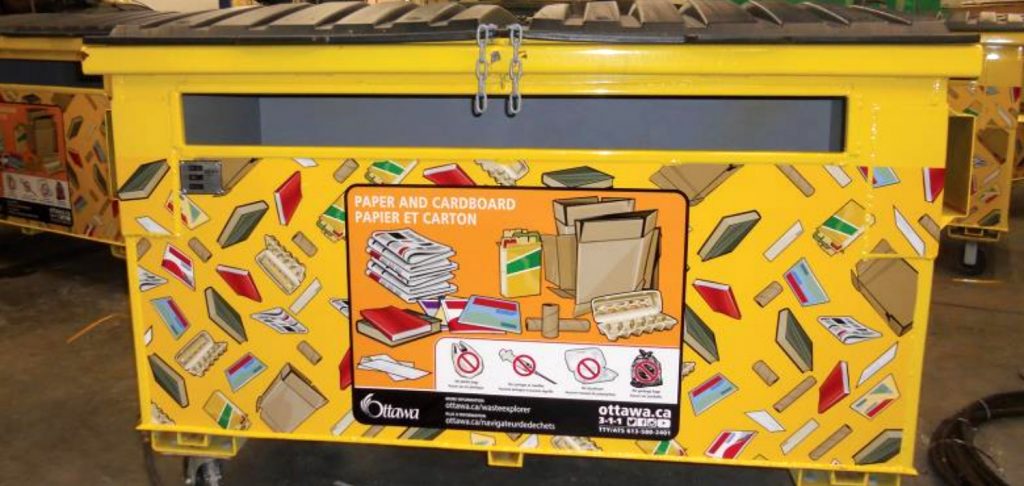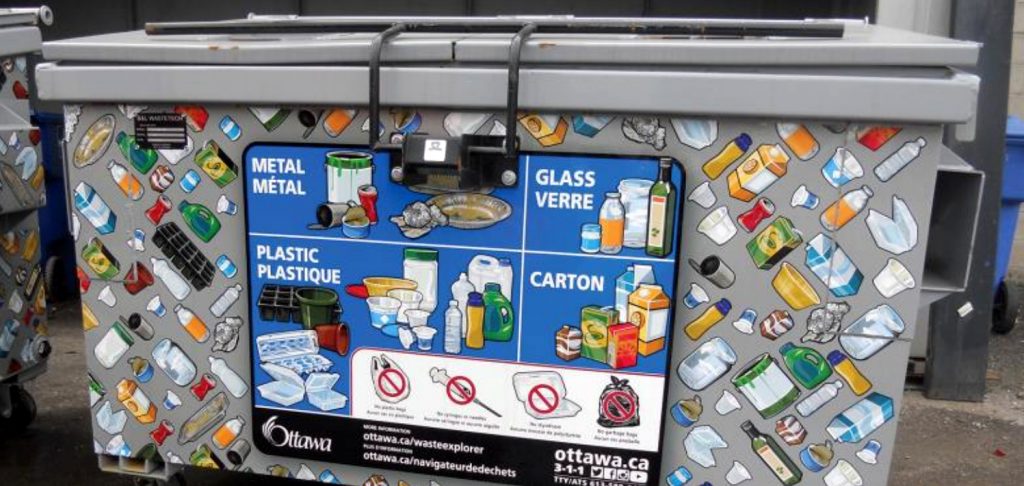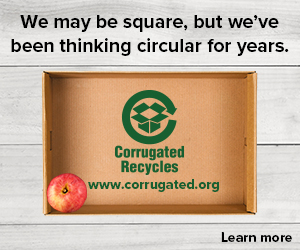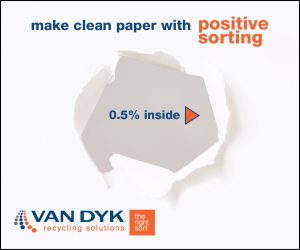Canada’s capital tested whether wrapping receptacles with splashy graphics of recyclables can improve capture rates and reduce contamination. The move can be effective, but such a strategy also has limitations.
The pilot project was conducted by the city of Ottawa at a multi-family public housing development in the city. Ottawa, population 935,000, has a dual-stream system with separate fiber and container collections. The project’s goal was to determine whether affixing colorful vinyl wraps with pictures of recyclables to front-end-loader bins would help residents get the right recyclables into the right bins.
The effort moved the needle noticeably on capture and contamination rates at the multi-family complex.
“Although the pilot met its objectives, without further analysis it would appear to be too costly to expand city-wide,” according to the report, authored by Laureen DiNardo of the Ottawa Public Works and Environmental Services. “Considering budget limitations, the bin wraps are an effective tool that might be best utilized in problematic areas with low recycling rates and high contamination rates.”
The project, which cost 75,000 Canadian dollars ($57,000) received funding from the Continuous Improvement Fund (CIF), an Ontario fund financed by municipalities and printed paper and packaging producers. CIF released the results of the project in December.

Struggling performance
Multi-family recycling performance is, in general, more challenged than the single-family residential recycling sector. Complicating factors include higher unit turnover, limited facilities and the need to get landlord buy-in.
In Ottawa, single-family households receive a black bin for fiber and a blue bin for mixed containers. But, for multi-family housing, the front-end-loading dumpsters don’t allow for those color schemes. Instead, the front of the containers feature an instructional sticker informing residents which materials go in which container.
In 2014, Ottawa’s multi-family sector notched a 16.4 percent diversion rate, according to the report. But properties owned by Ottawa Community Housing came in lower, at 9 percent.
The pilot project took place at a 600-unit Ottawa Community Housing development called Wiggins Private, located in downtown Ottawa. Collection service is provided by Waste Connections, the third largest residential garbage and recycling hauler in North America. Recyclables sorting is provided by Cascades, a major paper product and packaging company that operates its own recycling facilities.
Many residents of the housing development are immigrants who don’t speak English or French. Additionally, some of them bring different ways of handling waste based on cultural practices in their countries of origin. On top of that, there’s high unit turnover, which presents problems even in situations where language isn’t a barrier.
To cut through the communication conundrum, the city used wraps showing items that should be placed in the containers.
Baseline audit
The city hired Ottawa firm Viridis Environmental to conduct pre- and post-project waste audits, which involved studying samples of garbage and recyclables from the housing complex (organics collection for composting is not provided).
The pre-project audits, which took place in November 2017, looked at material gathered in the old containers with the smaller stickers. The post-project audits, conducted in June 2018, examined material gathered in new bins wrapped with the attention-grabbing vinyl.
Both audits took place at Trail Road Landfill Site, a city-run facility, and involved hand-sorting and weighing by eight to 10 people.
Data generated from the pre-project audit show the fiber stream had a 29 percent capture rate and a 13 percent contamination rate. The mixed container stream had a 16 percent capture rate and a 38 percent contamination rate. The overall recycling rate was 6.8 percent.
As far as contamination was concerned, the fiber stream had a lot of “other” assorted contaminants, quite a bit of organic material, and some amount of mixed containers. The mixed container stream, which is supposed to be made up of plastic, metal, glass and carton containers, had a lot of “other” contamination, quite a bit of fiber, and a small amount of organic compostables.
Overall, there was potential for better: The audits showed 23 percent of the landfilled waste could have been recycled via the fiber or mixed-container bins. In particular, auditors found lots of printed paper, OCC and boxboard in the garbage.

Project results
After the baseline audit, 21 bins wrapped with vinyl graphics were installed at the housing complex. In November 2017, flyers and brochures were delivered to 585 housing units. The outreach materials explained the new container labels and listed the appropriate materials for each bin.
Waste and recyclables audits in June showed the fiber stream’s capture rate had increased to 40 percent (up 11 percentage points) and the contamination rate decreased to 7 percent (down 6 percentage points). The mixed-container capture rate increased to 23 percent (up 7 percentage points) and its contamination rate dropped to 28 percent (down 10 percentage points).
Overall, the recycling rate increased to 8.9 percent, up 2.1 percentage points. Combing through the garbage showed that about 19.2 percent of landfilled waste could have been diverted via the fiber or mixed-container bins. Again, they found quantities of printed paper, OCC and boxboard in the garbage. This time, they noted PET bottles and jars in the garbage, too.
Researchers ruled out the possibility that the pre- and post-project results be caused by seasonal changes: They looked at citywide data and found that both single-family and multi-family recycling bins saw decreased tonnages from November 2017 to June 2018. Wiggins Private saw substantial increases during the same time.
Big takeaways
The city shared a few lessons for others who may be interested in conducting a similar project.
First, staff noted the inability to apply the vinyl wraps to dented, rusty bins. For the project, the city bought new bins. But if existing bins are used, the city suggested using only clean, freshly painted ones with minimal dents and rust.
Another piece of advice was to use a vinyl laminate with an over-laminate sealer to extend bin life and make graffiti removal easier. They noted the vinyl requires temperatures of at least 50 degrees Fahrenheit to apply.
The study also involved a financial cost-benefit analysis that took into account bin and wrap costs, commodity values, savings in sorting costs and landfill disposal charges. It costs about $530 to buy and apply each vinyl wrap. For the fiber stream, it would take nearly seven years to pay back the wrap costs. The payback period rises to 8 years for a mixed-container wrap.
If the cost of buying a new bin is included, the theoretical payback periods are pushed out roughly two decades (the report noted the life expectancy of a bin is about 10 years). Researchers noted the payback period vary dramatically based on assumptions of future recovered commodities value. They also noted the wrap costs could be lowered by buying in bulk.
DiNardo’s analysis also noted the calculations don’t take into account other benefits, including increased marketing of the recycling program and graffiti deterrence (by providing less of a blank slate to tempt spray paint cans).
Still, she suggested other municipalities interested in the communications strategy align the timing of their wrap installations with their programs’ scheduled bin replacements. Doing so could save money on capital and/or bin cleaning and painting costs.
“The pilot outcome suggests that the bin wraps are an effective tool to utilize in the most problematic areas with low recycling rates and high contamination raes when the capital expenditure for new bins is anticipated,” she wrote. “The city of Ottawa will be reviewing this approach as part of the long-term waste management strategy.”
Photos courtesy of Continuous Improvement Fund.
More stories about collection
- Colorado $10m grant fuels new MRF on state’s Western Slope
- Federal Signal paves new way with acquisition
- Interstate Waste buys North Atlantic in Connecticut



